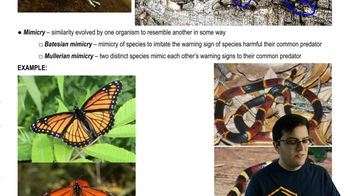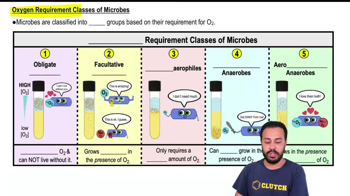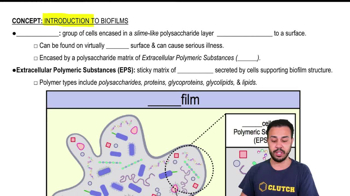Table of contents
- 1. Introduction to Biology2h 42m
- 2. Chemistry3h 40m
- 3. Water1h 26m
- 4. Biomolecules2h 23m
- 5. Cell Components2h 26m
- 6. The Membrane2h 31m
- 7. Energy and Metabolism2h 0m
- 8. Respiration2h 40m
- 9. Photosynthesis2h 49m
- 10. Cell Signaling59m
- 11. Cell Division2h 47m
- 12. Meiosis2h 0m
- 13. Mendelian Genetics4h 44m
- Introduction to Mendel's Experiments7m
- Genotype vs. Phenotype17m
- Punnett Squares13m
- Mendel's Experiments26m
- Mendel's Laws18m
- Monohybrid Crosses19m
- Test Crosses14m
- Dihybrid Crosses20m
- Punnett Square Probability26m
- Incomplete Dominance vs. Codominance20m
- Epistasis7m
- Non-Mendelian Genetics12m
- Pedigrees6m
- Autosomal Inheritance21m
- Sex-Linked Inheritance43m
- X-Inactivation9m
- 14. DNA Synthesis2h 27m
- 15. Gene Expression3h 20m
- 16. Regulation of Expression3h 31m
- Introduction to Regulation of Gene Expression13m
- Prokaryotic Gene Regulation via Operons27m
- The Lac Operon21m
- Glucose's Impact on Lac Operon25m
- The Trp Operon20m
- Review of the Lac Operon & Trp Operon11m
- Introduction to Eukaryotic Gene Regulation9m
- Eukaryotic Chromatin Modifications16m
- Eukaryotic Transcriptional Control22m
- Eukaryotic Post-Transcriptional Regulation28m
- Eukaryotic Post-Translational Regulation13m
- 17. Viruses37m
- 18. Biotechnology2h 58m
- 19. Genomics17m
- 20. Development1h 5m
- 21. Evolution3h 1m
- 22. Evolution of Populations3h 52m
- 23. Speciation1h 37m
- 24. History of Life on Earth2h 6m
- 25. Phylogeny2h 31m
- 26. Prokaryotes4h 59m
- 27. Protists1h 12m
- 28. Plants1h 22m
- 29. Fungi36m
- 30. Overview of Animals34m
- 31. Invertebrates1h 2m
- 32. Vertebrates50m
- 33. Plant Anatomy1h 3m
- 34. Vascular Plant Transport1h 2m
- 35. Soil37m
- 36. Plant Reproduction47m
- 37. Plant Sensation and Response1h 9m
- 38. Animal Form and Function1h 19m
- 39. Digestive System1h 10m
- 40. Circulatory System1h 57m
- 41. Immune System1h 12m
- 42. Osmoregulation and Excretion50m
- 43. Endocrine System1h 4m
- 44. Animal Reproduction1h 2m
- 45. Nervous System1h 55m
- 46. Sensory Systems46m
- 47. Muscle Systems23m
- 48. Ecology3h 11m
- Introduction to Ecology20m
- Biogeography14m
- Earth's Climate Patterns50m
- Introduction to Terrestrial Biomes10m
- Terrestrial Biomes: Near Equator13m
- Terrestrial Biomes: Temperate Regions10m
- Terrestrial Biomes: Northern Regions15m
- Introduction to Aquatic Biomes27m
- Freshwater Aquatic Biomes14m
- Marine Aquatic Biomes13m
- 49. Animal Behavior28m
- 50. Population Ecology3h 41m
- Introduction to Population Ecology28m
- Population Sampling Methods23m
- Life History12m
- Population Demography17m
- Factors Limiting Population Growth14m
- Introduction to Population Growth Models22m
- Linear Population Growth6m
- Exponential Population Growth29m
- Logistic Population Growth32m
- r/K Selection10m
- The Human Population22m
- 51. Community Ecology2h 46m
- Introduction to Community Ecology2m
- Introduction to Community Interactions9m
- Community Interactions: Competition (-/-)38m
- Community Interactions: Exploitation (+/-)23m
- Community Interactions: Mutualism (+/+) & Commensalism (+/0)9m
- Community Structure35m
- Community Dynamics26m
- Geographic Impact on Communities21m
- 52. Ecosystems2h 36m
- 53. Conservation Biology24m
26. Prokaryotes
Prokaryotic Metabolism
Problem 9`
Textbook Question
Cyanide (C ≡ N−) blocks complex IV of the electron transport chain. Suggest a hypothesis for what happens to the ETC when complex IV stops working. Your hypothesis should explain why cyanide poisoning in humans is fatal.
 Verified step by step guidance
Verified step by step guidance1
Understand the role of complex IV in the electron transport chain (ETC). Complex IV, also known as cytochrome c oxidase, is responsible for the final step of electron transfer to oxygen, forming water. This step is crucial for maintaining the proton gradient across the mitochondrial membrane.
Recognize the impact of cyanide on complex IV. Cyanide binds to the iron within cytochrome c oxidase, inhibiting its function. This prevents the transfer of electrons to oxygen, effectively halting the ETC.
Formulate a hypothesis: If complex IV is blocked by cyanide, electrons cannot be transferred to oxygen, leading to a cessation of ATP production. This is because the proton gradient necessary for ATP synthesis by ATP synthase is disrupted.
Explain the consequences of the hypothesis: Without ATP production, cells cannot perform essential functions, leading to cell death. Since ATP is vital for energy-dependent processes, cyanide poisoning results in rapid organ failure and is fatal.
Consider the broader implications: Cyanide poisoning affects all cells reliant on aerobic respiration, particularly those with high energy demands like neurons and cardiac cells, explaining the rapid onset of symptoms and fatality.
 Verified video answer for a similar problem:
Verified video answer for a similar problem:This video solution was recommended by our tutors as helpful for the problem above
Video duration:
2mPlay a video:
Was this helpful?
Key Concepts
Here are the essential concepts you must grasp in order to answer the question correctly.
Electron Transport Chain (ETC)
The electron transport chain is a series of protein complexes located in the inner mitochondrial membrane that facilitates the transfer of electrons from electron donors to oxygen. This process generates a proton gradient across the membrane, which is used to produce ATP, the cell's energy currency. Disruption of the ETC can halt ATP production, leading to cellular energy failure.
Recommended video:
Guided course

Electron Transport Chain
Complex IV Function
Complex IV, also known as cytochrome c oxidase, is the final enzyme in the electron transport chain. It facilitates the transfer of electrons to oxygen, forming water. This step is crucial for maintaining the proton gradient necessary for ATP synthesis. Inhibition of complex IV prevents electron transfer to oxygen, disrupting ATP production and leading to energy depletion in cells.
Recommended video:

Origin of Complex Traits
Cyanide Poisoning
Cyanide is a potent inhibitor of complex IV, blocking the electron transport chain and preventing ATP synthesis. Without ATP, cells cannot perform essential functions, leading to rapid cell death. In humans, cyanide poisoning is fatal because it causes widespread energy failure in vital organs, particularly the brain and heart, which rely heavily on aerobic respiration for energy.
Recommended video:
Guided course

Mimicry

 2:57m
2:57mWatch next
Master Nutritional Factors of Microbial Growth with a bite sized video explanation from Jason
Start learningRelated Videos
Related Practice












